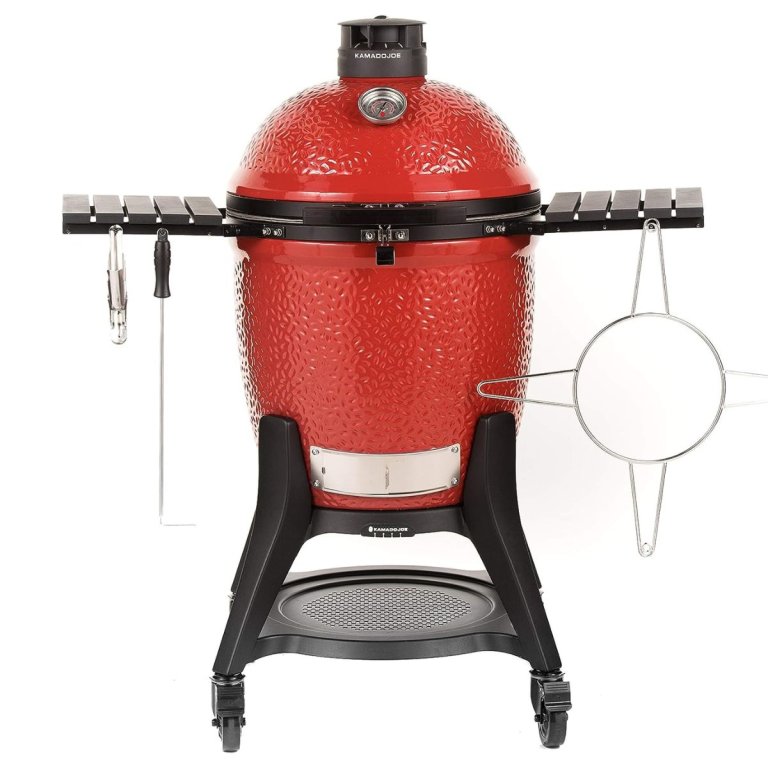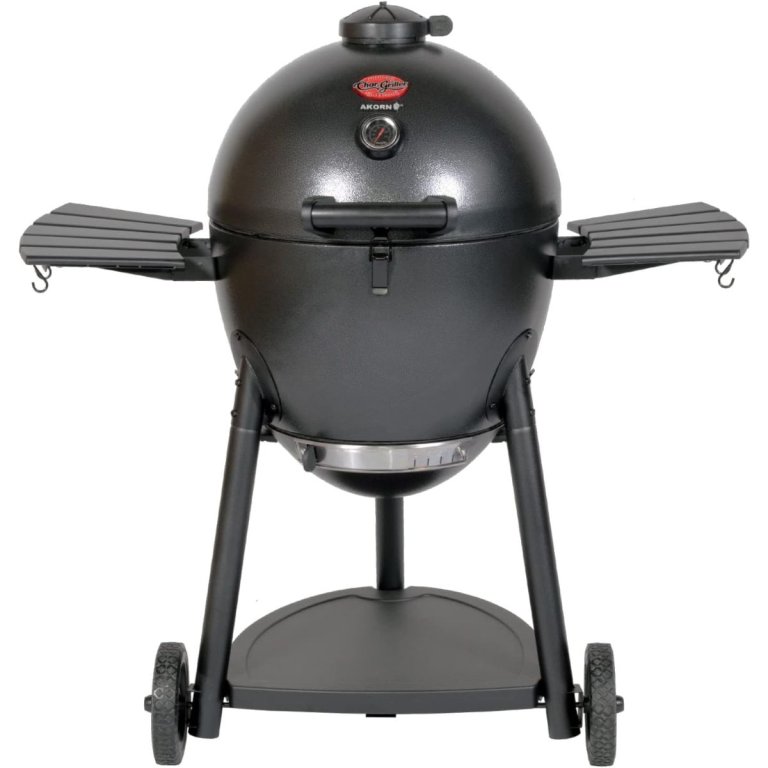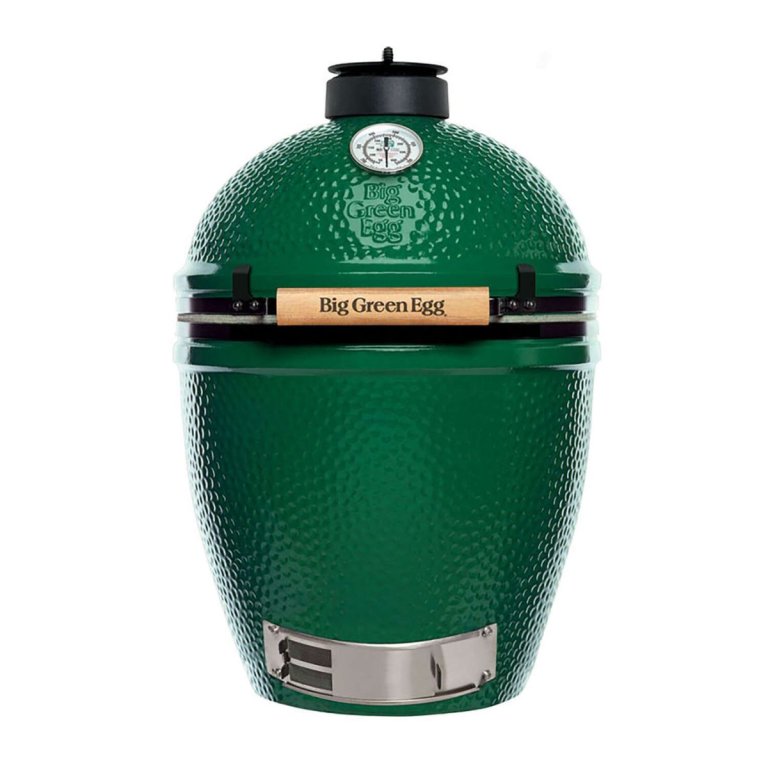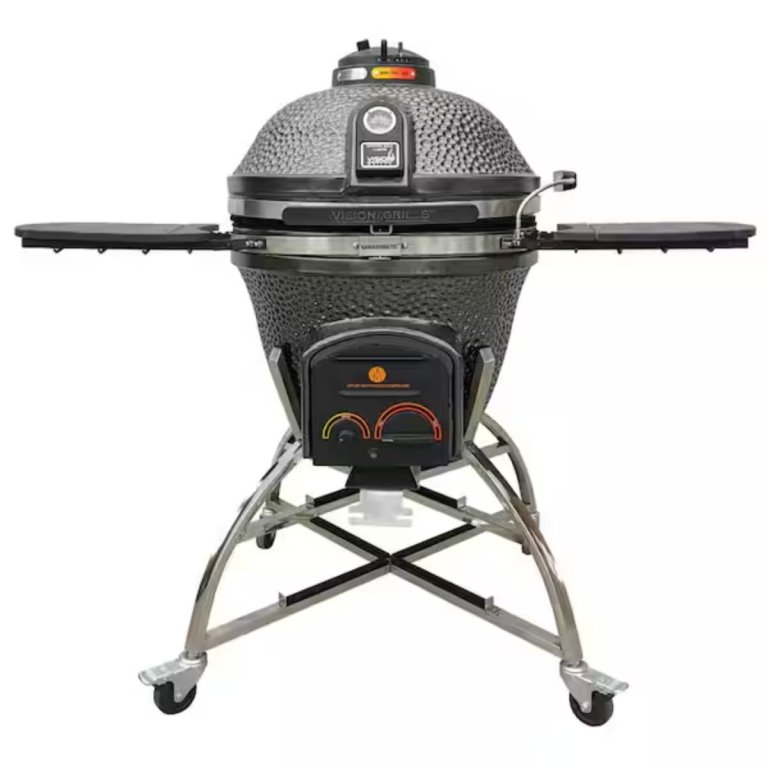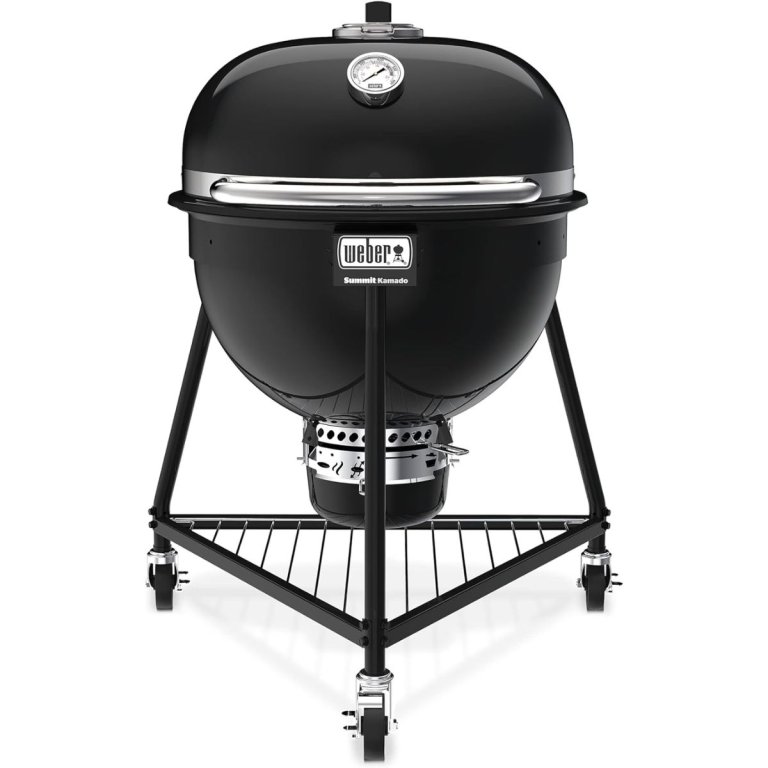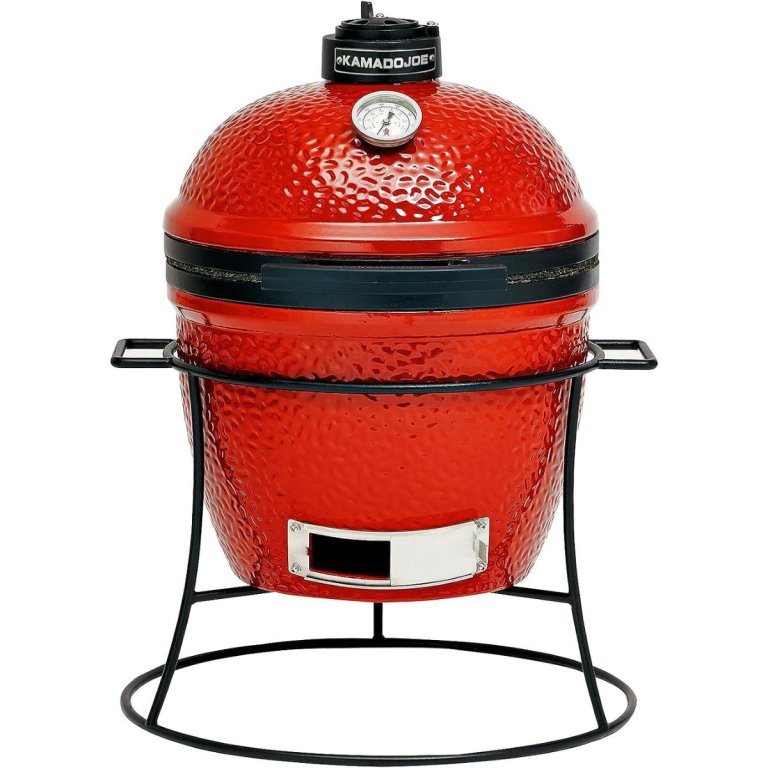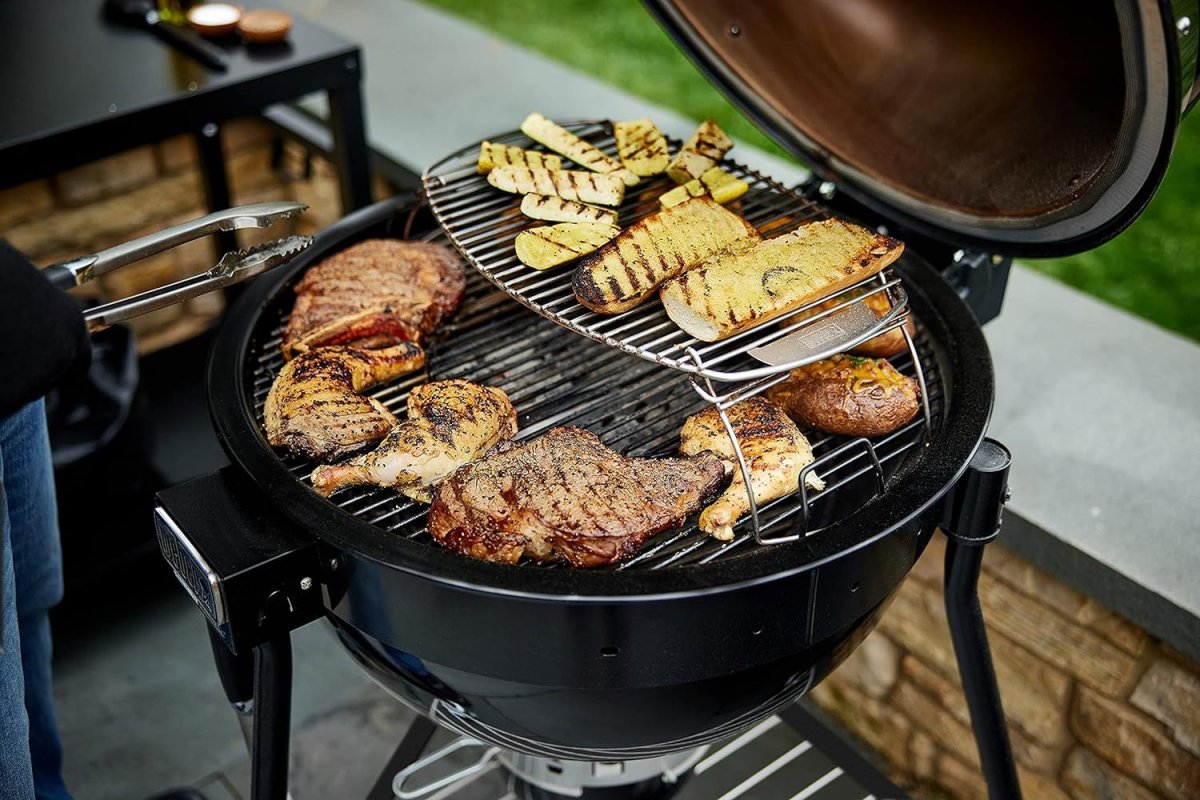
We may earn revenue from the products available on this page and participate in affiliate programs. Learn More ›
Patterned after a traditional method of Japanese cooking called kamado, ceramic kamado grills are popping up in backyards everywhere. Home chefs revere these charcoal-fueled cookers to smoke meat slowly until it’s so tender it falls off the bone. But versatile kamados aren’t one-trick wonders: They can get blazing hot enough to put the perfect sear on a steak and even create crispy-crusted pizzas.
The best egg grill smoker (so-called for its oval shape) for you can be a basic no-frills model or a high-end ceramic grill with such features as split grates, oversize locking wheels, and a multipanel firebox. Read on for shopping tips and recommendations for the best kamado grills on the market.
- BEST OVERALL: Kamado Joe Classic Joe Series III Grill
- BEST BANG FOR THE BUCK: Char-Griller E16620 Akorn Kamado Charcoal Grill
- UPGRADE PICK: Big Green Egg (Large)
- BEST FOR ENTERTAINING: Vision Grills XD702 Maxis Ceramic Kamado Grill
- MOST VERSATILE: Weber Summit Kamado E6 Charcoal Grill
- BEST TABLETOP: Kamado Joe Joe Jr. KJ13RH With Cast-Iron Stand
- ALSO CONSIDER: Primo Grills All-in-One Oval XL 400 Kamado Grill

How We Chose the Best Kamado Grills
We researched a wide range of popular kamado grills, taking into account the different types available and the materials they’re constructed of as well as their heat output, control, and portability. We also kept price in mind and included affordable options as well as ones shoppers could splurge on. We also took the time to note the pros and cons of each model that we recommended. You’re sure to find the best kamado grill for your needs from our vetted list.
Our Top Picks
The following is a list of some of the best kamado grills available on the market. Check out each one below to decide which model might be right for you.
Best Overall
Kamado Joe Classic Joe Series III Grill
Pros
- The SlōRoller hyperbolic insert converts the grill instantly into a smoker
- The Air Lift hinge significantly reduces the dome’s weight, making it easier to lift and lower
- Includes a heavy-duty powder-coated steel grill cart for transport
Cons
- Quite heavy at 360 pounds, although the stand and wheels do assist with transport
Product Specs
- Cooking surface: 250 square inches
- Weight: 360 pounds
- Capacity: 13 burgers, 4 chickens, 2 pork butts
The Kamado Joe Classic Joe Series III grill offers 250 square inches of cooking area on an 18-inch split grate. Its three-tier Divide & Conquer cooking system means you can cook various foods at different temperatures. There’s a helpful temperature gauge, and the Kontrol Tower top vent maintains consistent airflow management when the dome is opened and closed. This allows you to smoke as low as 225 degrees Fahrenheit and sear at up to 750 degrees Fahrenheit.
The body of the Kamado Joe is made from powder-coated cast aluminum, and the interior is ceramic. It comes with a rolling grill cart that has a storage shelf and wheels. This 360-pound kamado grill also includes a grill gripper and an ash tool.
Get the Kamado Joe Classic kamado grill at Amazon, The Home Depot, or Kamado Joe.
Best Bang for the Buck
Char-Griller E16620 Akorn Kamado Charcoal Grill
Pros
- Convenient EasyDump ash pan allows for quick and easy cleanup
- Users can keep food warm with removable chrome-plated steel warming rack
- Includes a grill grate, cast-iron cooking grates, locking wheels, and 2 folding side shelves
Cons
- Some buyers found assembly to be difficult
Product Specs
- Cooking surface: 314 square inches (primary cooking area); 447 square inches (total cooking area)
- Weight: 85 pounds
- Capacity: 23 burgers
With the Char-Griller Akorn Kamado Grill, users get 314 square inches of cast-iron cooking grate at a budget-friendly price, plus an extra 133 square inches on the warming rack. The Char-Griller’s egg-shaped body is built with triple-wall insulation allowing for maximum heat retention, fuel efficiency, and longer burn times.
Near the top of the grill’s hinged lid sits a handy temperature gauge (200 to 700 degrees Fahrenheit) and a vent. A tubular steel cart supports the unit, and rubber wheels and locking casters make it mobile. The cart and grill together weigh in at 85 pounds.
Get the Char-Griller kamado grill at Amazon or The Home Depot.
Upgrade Pick
Big Green Egg (Large)
Pros
- High-quality build; very reliable and it works with a number of accessories
- Calibrated temperature gauge can read precise temperatures from 150 to 750 degrees Fahrenheit
- Versatile; functions as a high-temperature grill, roaster, low-and-slow smoker, and outdoor oven
Cons
- Does not come with a stand; users must purchase an Egg Table or Nest separately
Product Specs
- Cooking surface: 262 square inches
- Weight: 162 pounds
- Capacity: 20-pound turkey; 12 burgers; 6 chickens (vertically); 8 steaks; or 7 racks of ribs (vertically)
Made of porcelain-glazed ceramic for exceptional durability, the Big Green Egg is airtight, holding heat for several hours. It includes a stainless steel cooking grate and a built-in temperature gauge that provides precise readings up to 750 degrees Fahrenheit. The Big Green Egg comes in seven sizes, from mini to 2XL.
The large Big Green Egg boasts a cooking area of 262 square inches and weighs in at 162 pounds. This efficient and versatile cooking vessel doesn’t use much charcoal and cooks a variety of foods on its 18.25-inch grate, from pork ribs to chicken wings, to perfection. Its high price tag, though not ideal, is offset by low, long-term maintenance costs and durable design.
What our tester says: Beth Cranston, a Bob Vila editor, notes that the Big Green Egg “is for outdoor cooking enthusiasts. To truly enjoy the Egg, you have to not only revel in the tasty results—from smoked ribs to seared steaks to pizza—but also in the cooking process. Whether it’s figuring out the optimal vent positions for the perfect temp or figuring out preferred wood chips for smoking, the process is part of the joy of this cooking experience.”
Read our full review: Big Green Egg
Get the Big Green Egg kamado grill at Ace Hardware, or find a dealer at Big Green Egg.
Best for Entertaining
Vision Grills XD702 Maxis Ceramic Kamado Grill
Pros
- Electric starter port means quick lighting; also comes with color-coded smoking and grilling knobs
- Includes lava stone for cooking pizzas, as well as a wheeled cart, grill light, and full-length cover
- Easy-lift KamadoMatic Hinge with a locking latch provides a tighter seal
Cons
- One of the heaviest kamado grills on our list
Product Specs
- Cooking surface: 724.5 square inches
- Weight: 264.6 pounds
- Capacity: N/A
A 724.5-square-inch grilling surface on this Vision Grills model provides ample room to cook for a crowd. The built-in thermometer displays the grill’s internal temperature without needing to lift the lid. This kamado grill weighs 264.6 pounds, but it sits in a stainless steel cart with four locking wheels to move—and then stay—around the deck or patio.
The XD702 grill features two simple, clearly labeled vent controls at the base to make it easier for grilling newbies to accurately control the temperature. A top vent is also labeled so that users can adjust the flow of heat accordingly. Shelves on either side add space for tools, cutlery, plates, rubs, and spices.
Get the Vision Grills kamado grill at The Home Depot or BBQGrills.com.
Most Versatile
Weber Summit Kamado E6 Charcoal Grill
Pros
- One-Touch Cleaning System with 3-blade design sweeps ash into removable ash catcher for simple cleanup
- Comes with durable stand that provides a rigid base for the grill
- Built-in thermometer and Char-Baskets that hold charcoal are included
Cons
- Complaints are few, but some buyers said they wish it came with more accessories
Product Specs
- Cooking surface: 452 square inches
- Weight: 132 pounds
- Capacity: 3 racks of ribs, 4 ears of corn, and a medium tray of vegetables
The adjustable fuel grate is the secret behind the Weber Summit Kamado E6’s versatility. Move the grate up higher for high-heat grilling or secure it in a lower position for all-day smoking, all while minimizing the amount of charcoal being burned. Its heavy-duty steel construction can hold up to the hottest temperatures, while its porcelain-enameled finish ensures that rust, cracks, and peeling paint won’t put a damper on your backyard get-together.
The hinged design of the Summit Kamado E6’s Rapidfire lid damper means that grillers can lift the lid fully open. This maximizes airflow and creates a chimney effect, which quickly increases temperatures and gets users grilling more quickly. For even more versatility, remove the cooking grate and insert a pizza stone, griddle, sear grate, or poultry roaster (accessories sold separately).
Get the Weber kamado grill at Amazon, The Home Depot, BBQGuys, or Weber.
Best Tabletop
Kamado Joe Joe Jr. KJ13RH With Cast-Iron Stand
Pros
- Lighter weight and portability make it perfect for tailgating and camping
- Allows users to add charcoal while cooking thanks to its hinged cooking grate
- Includes stainless steel stand with carrying handles for easier transport
Cons
- Complaints are rare, but some buyers felt it was heavy for a portable grill
Product Specs
- Cooking surface: 150 square inches
- Weight: 77.2 pounds
- Capacity: 7 burgers or 2 whole chickens
Made of heavy ceramic, the Kamado Joe Jr. is pretty weighty for a tabletop model at 77.2 pounds, but it includes a stainless steel stand with carrying handles for easier lifting. It features a circular stainless steel grate with a 150-square-inch grilling surface.
The grill is controlled with a bottom vent for oxygen flow and a top vent to release smoke and heat. It also includes a temperature gauge built into the lid for effective, accurate heat management. Ceramic isn’t susceptible to rusting or water damage, making this tabletop grill a good choice for humid environments, from poolside parties to beach barbecues.
Get the Kamado Joe Joe Jr. kamado grill at Amazon, The Home Depot, or Kamado Joe.
Also Consider
Primo Grills All-in-One Oval XL 400 Kamado Grill
Pros
- Wide temperature range of 151 to 850 degrees Fahrenheit
- Easy-lift hinge reduces the force needed to open the lid by 70 percent
- 6-position aluminum damper at the top allows more precise temperature control
Cons
- Does not come with a stand; cradle or base must be purchased separately
Product Specs
- Cooking surface: 400 square inches
- Weight: 250 pounds
- Capacity: 8 whole chickens; 2 whole turkeys; 12 steaks; 20 burgers; 10 racks of ribs; or 12 ears of corn
The Primo Grills Oval XL’s 400-square-inch cooking surface can accommodate quite a lot of food; home chefs can fit eight whole chickens, two whole turkeys, or a whopping 20 burgers at one time inside this kamado grill. And if you need even more space, you can purchase an extended cooking grate, which will increase the cooking surface by 30 percent.
Configure the inside for grilling, searing, roasting, baking, or smoking. Other features include a cast-iron top vent, an easy-to-read thermometer, and a five-position lower air control slider that allows users to control the amount of airflow into the charcoal. Primo Grills offers a wide range of accessories that can be purchased separately, including a rotisserie spit, firebox divider, five- or nine-slot rib rack, and a cast-iron griddle. There’s not much this grill can’t do.
Get the Primo Grills kamado grill at Amazon or BBQGrills.com, or find a local dealer at Primo Grills.
Jump to Our Top Picks
What to Consider When Choosing a Kamado Grill
To find the right model for your needs, take some time to learn about these barbecue breakthroughs, including the types of kamado grills available and material, weight, heat output, and portability. Once you get a handle on the factors and features of these specialty charcoal grills, you’ll be better prepared to select the best kamado grill for your home.
Type
Kamado grills are differentiated based on size, style, and portability. The various types available include freestanding, built-in, tabletop, and portable kamado grills.
- Freestanding or cart-style kamado grills will usually have a set of sturdy legs that supports the egg-shaped charcoal grill. These have a main cooking area that is typically split into two half-circle grates that sit at different heights for easy access to both surfaces. Cart-style kamado grills may also have locking wheels on each leg to make it easier to move the unit across a flat surface. The original Kamado Joe Classic is a prime example of a freestanding kamado grill.
- Built-in kamado grills are semipermanent fixtures that are built into an outdoor patio. These high-end premium grills are constructed and installed with rugged materials such as brick, mortar, concrete, cast iron, tile, and steel.
- Tabletop kamado grills are a good choice for entertaining small groups because the grill can sit right at the table for easy access to moderate portions of steak, shish kebab, and grilled finger foods. They typically have a heat-resistant base or a set of legs to support the grill while protecting the table.
- Portable kamado grills can range in size from small tabletop options to large freestanding units, but in order for a grill to be considered portable, it must be easy to carry or have features that make it simple to move around, like a set of locking wheels or a detachable base.
Material
Kamado grills are known for the ceramic interior that helps to retain heat, but these grills are typically made with other materials, too (in particular, plastic and steel).
- Ceramic is the most commonly used material for kamado grills. It’s great for high-humidity and rain-prone locations because ceramic cannot rust. Ceramic also has the benefit of heating up gradually and holding on to the heat for a long time, making kamado grills suitable for smoking roasts or cuts of brisket. The downside is that ceramic isn’t as durable as stainless steel, and it is susceptible to chipping.
- Steel is a high-durability material typically used on the exterior of a grill, but it may also be used for the grill grates in a kamado grill. It’s a lightweight material that’s resistant to water, ultraviolet radiation, and impact damage. Kamado grills may have stainless steel grates and powdered or painted steel exteriors to help protect the grill from corrosion.
- Plastic, an excellent insulating material and a poor heat conductor, is regularly used to make the parts of the kamado grill that need to be cool to the touch. This includes side shelves, handles, and even some lightweight grill carts.
Cooking Surface
When it comes to determining the best kamado grill, its cooking surface is one of the most important factors. A smaller grill suitable for cooking 10 to 12 hamburger patties needs at least 250 square inches of cooking surface. A medium to large kamado grill may have 450 to 500 square inches of cooking surface and will hold up to 24 hamburger patties.
Some kamado grills come with adjustable grates to cook a variety of different foods at the same time, simply by changing the position of the grates. When choosing a grill size, it’s usually better to go for a larger model in case of unexpected guests or the urge to cook additional items, such as corn on the cob or shish kebab.
Heat Output and Control
Heat output is determined by the burning charcoal in the base of the kamado grill. However, controlling the heat on a kamado grill isn’t as simple as turning a knob or pushing a button, as on gas grills. Instead, all charcoal grills, including kamado grills, require the cook to manually control the flow of air to raise or lower the temperature.
The key to cooking food properly on a kamado grill is controlling the temperature. Vents in the hood and chamber can be manually adjusted to allow increased oxygen and airflow into or out of the grill. You can also control the heat by altering the distance between the food and the flames by raising or lowering the charcoal and cooking grates.
Weight and Portability
Kamado grills come in a variety of weight options from about 10 pounds for tabletop and small portable models to extra-large units weighing more than 200 pounds. If mobility around a patio or deck area is desired, all that’s usually needed is a set of wheels.
Some grills have two stationary feet and two wheels, allowing users to lift one end and move the grill freely. Other products have four locking wheels, so no lifting is required—just make sure to lock the wheels before using the grill. Small, lightweight grills may have folding legs or removable legs to make it easier to pick up and pack the grill for road trips, tailgate parties, and camping.
Additional Features
Simple grills are great, but manufacturers have begun incorporating additional features to help make their products stand out. Some of the bells and whistles available on kamado grills include built-in thermostats, warming racks, and side shelves.
- Built-in thermostats display the current temperature inside the grill. Using this simple reading, grill chefs can raise or lower the heat output so that food is prepared at the desired temperature.
- Warming racks increase the total cooking surface and give users a place to prepare foods that don’t need as much heat, such as buns. The racks also keep cooked food warm until plating and serving.
- Side shelves are an excellent addition to any kamado grill because they give users multiple places to put food, grill tools, plates, sauces, and other accessories.
FAQs
Kamado grills offer an excellent way to upgrade your barbecue skills and enhance your outdoor hosting. But if you’re still uncertain about various benefits of these products or how to maintain them, continue reading for answers to some of the most commonly asked questions.
Yes, a kamado grill can be used effectively for smoking foods because its thick, insulated body has excellent heat retention. This allows large roasts or cuts of brisket to slow cook over several hours as smoke fills the chamber, giving the food that distinctive smoky flavor.
These grills are typically made with ceramic, which has high heat retention. Though ceramic takes a while to heat up, it will hold and radiate heat longer than a standard grill. What’s more, the narrow egg shape reduces airflow on food so that steaks, roasts, and ribs stay moist. Due to the thick, insulated ceramic body, a kamado grill can also be used for smoking food over low temperatures for a long period of time.
The size and shape of a kamado grill and smoker differ between products, so it’s advised to choose a grill that fits comfortably in your outdoor space and that has a suitable cooking surface to prepare food for your family. For the average user, a kamado grill and smoker with about 250 to 500 square inches of cooking space is ideal.
Users will want to perform basic cleaning before and after every use to keep the food tasting great and the grill and smoker working properly. Use a grill brush to remove stuck-on food, sauce, spices, and other burned food items.
Built-up grease and grime can clog air vents, affecting the temperature control of the grill, so it may occasionally be necessary to use grill cleaner and an abrasive scrubbing pad.
Remove each piece from the interior of the grill, including grates, burner protectors, and the entire catch basin at the bottom, and carefully clean it with a grill cleaner before rinsing, drying, and returning it to its position inside the grill.
The average kamado grill will last about 10 years, provided it’s maintained properly and protected with a grill cover when not in use.



